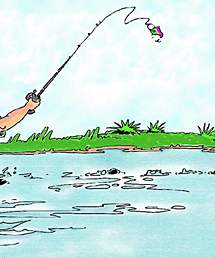|
Fresh Perspective

By Paul Cañada
Page 2
Having thrown my only conventional saltwater lure to the bottle-nosed dolphin, I naturally asked my guide for some advice. He explained that redfish will hit "anything that gets close enough to seize the fish's attention." Hudson, I learned, prefers Super Spooks, Pop-Rs, Top Dogs and other topwater baits. I was surprised to find that many of Hudson's favorite lures-for example, the Bass Assassin and the aforementioned Spook-are baits originally popularized by bass fisherman.
Bingo! I found the perfect lure-an Excalibur Spittin' Image. The shad-like surface lure, I reasoned, is a dead-ringer for a baitfish. And if bass can't refuse it, I doubted the redfish would look away. I am proud to say that my ever-attentive fishing guide carefully looked it over and nodded his approval.
The bait looked good in the water-as did Hudson's Super Spook-but the redfish were nowhere to be found. As is often the case, I quickly got bored and decided to change out my bait. I dropped my rod and reel back into the salt bath and looked to my bag of tricks.
Maybe, I reckoned, the fish want something that scoots over the grass. So I switched to one of my "can't miss" bass rigs for fishing the skinny water over hydrilla, a Kalin Super Floozy. I Texas-rigged the soft plastic twitch bait on a Gamakatsu 2/0, extra-wide-gap hook at the end of a 12-inch leader attached to a stout barrel swivel. The rig casts well, doesn't spook shallow fish when it hits the surface and is weighted perfectly for fishing the thin water and grass found carpeting the salt flats.
Again, Hudson nodded his head in approval.
Lessons Learned-Day Two
The next morning, I headed out with Rockport guide Robert Hamilton for a day of fly fishing. I couldn't wait to ask him about stalking strategies and tidal patterns.
Hamilton began the lesson. "The redfish like to stay shallow," he said, "so when I'm fly fishing I look for skinny water. The back bays and lakes are some of the best places for flycasting because the fish get in water so shallow that their backs stick up out of the water."
Hamilton explained that many anglers favor the high tide because it makes it easier to access the shallowest flats. However, the Rockport guide questions their reasoning. He prefers to fly fish during a low tide, when the fish are concentrated in the deepest pools of the back bays and lakes, and along the edges between the shallow flats and relatively deeper water.
"Edge, did you say edge?" My bassin' wheels began churning in my head. "Robert, I thought I heard you say 'edge,' as in 'depth change' or 'drop off.'"
Hamilton verified that the low tide concentrates the redfish along that depth change, making it easier for a fly angler to locate them. It seems the redfish position-similar to largemouth bass feeding on a tidal river or a delta system-so as to intercept the baitfish and other critters that follow the tide out.
Depth, Hamilton explained, is a relative term. "When talking about redfish," he said, "6 to 8 inches is shallow water. On the flats, deep water is about 3 feet. If you're fishing water deeper than 4 feet, I think you're in the wrong spot."
With the boat securely anchored, Hamilton and I headed up over a grassy bog and into a lake. Before we separated, he gave me a few words of advice.
"You need to patiently stalk these fish. Be very careful to move quietly and slowly, and watch that you don't line the fish."
Admittedly, I am easily distracted and prone to daydream. I didn't really hear a whole lot of what Hamilton had to say. Looking around, I couldn't help but think of the Everglades. So, I asked the obvious.
"Robert, do you get any 'gators in these back bays?"
"Every once in a while you'll see a big one," was his matter-of-fact reply.
Instantly, I found the stingray shuffle extremely difficult to execute. With every step I took, my ankle would turn or my foot would sink deeper than I had expected. Hamilton explained that in boggy bays and lakes, the bottom can be tough to manage. "Not to worry," he encouraged, "you'll eventually develop your balance."
Splash! I toppled to my side a half-dozen times, fell backwards three times and eventually fell to my knees. Thinking back, I now realize it was a miracle that I didn't break my fly rod or flop belly down into the brine. Not surprisingly, the only redfish I saw that day were those speeding away from me like torpedoes.
Finally, just in front of me-maybe 30 feet-was a pod of tailing fish. I stood frozen, mouth gaped open, yet unable to speak. Moments quickly passed as I struggled to remember what Hamilton said. All I could remember was, "Don't line the fish."
I carefully calculated the distance, quietly lifted my fly line off the water and sent it airborne. My fly-a Kirk's Rattle Rouser-shot forward and clumsily landed mere inches from the fish.
Fortunately, the red didn't spook and I began a cadence of strips and pauses.
"Paul," Hamilton shouted, "what are you doing?"
"I am working a pod of redfish over to my right," I enthusiastically replied.
"Those aren't redfish," he moaned. "You're fishing over a group of mullet."
(Editor's note: Elton Hudson guides out of Rockport and can be reached at 512-790-8560; Robert Hamilton also guides out of Rockport, and can be reached at 512-729-1142.) # # # #
page 1 / page 2
| 




